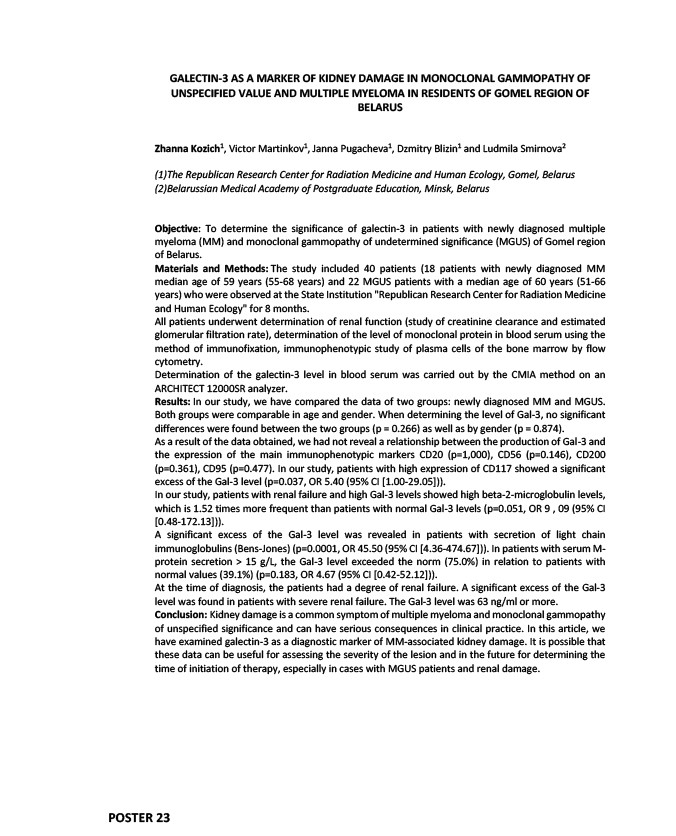
GALECTIN-3 AS A MARKER OF KIDNEY DAMAGE IN MONOCLONAL GAMMOPATHY OF
UNSPECIFIED VALUE AND MULTIPLE MYELOMA IN RESIDENTS OF GOMEL REGION OF
POSTER 23
BELARUS
Zhanna Kozich1, Victor Martinkov1, Janna Pugacheva1, Dzmitry Blizin1 and Ludmila Smirnova2
(1)The Republican Research Center for Radiation Medicine and Human Ecology, Gomel, Belarus
(2)Belarussian Medical Academy of Postgraduate Education, Minsk, Belarus
Objective: To determine the significance of galectin-3 in patients with newly diagnosed multiple
myeloma (MM) and monoclonal gammopathy of undetermined significance (MGUS) of Gomel region
of Belarus.
Materials and Methods: The study included 40 patients (18 patients with newly diagnosed MM
median age of 59 years (55-68 years) and 22 MGUS patients with a median age of 60 years (51-66
years) who were observed at the State Institution "Republican Research Center for Radiation Medicine
and Human Ecology" for 8 months.
All patients underwent determination of renal function (study of creatinine clearance and estimated
glomerular filtration rate), determination of the level of monoclonal protein in blood serum using the
method of immunofixation, immunophenotypic study of plasma cells of the bone marrow by flow
cytometry.
Determination of the galectin-3 level in blood serum was carried out by the CMIA method on an
ARCHITECT 12000SR analyzer.
Results: In our study, we have compared the data of two groups: newly diagnosed MM and MGUS.
Both groups were comparable in age and gender. When determining the level of Gal-3, no significant
differences were found between the two groups (p = 0.266) as well as by gender (p = 0.874).
As a result of the data obtained, we had not reveal a relationship between the production of Gal-3 and
the expression of the main immunophenotypic markers CD20 (p=1,000), CD56 (p=0.146), CD200
(p=0.361), CD95 (p=0.477). In our study, patients with high expression of CD117 showed a significant
excess of the Gal-3 level (p=0.037, OR 5.40 (95% CI 1.00-29.05)).
In our study, patients with renal failure and high Gal-3 levels showed high beta-2-microglobulin levels,
which is 1.52 times more frequent than patients with normal Gal-3 levels (p=0.051, OR 9 , 09 (95% CI
0.48-172.13)).
A significant excess of the Gal-3 level was revealed in patients with secretion of light chain
immunoglobulins (Bens-Jones) (p=0.0001, OR 45.50 (95% CI 4.36-474.67)). In patients with serum M-protein
secretion > 15 g/L, the Gal-3 level exceeded the norm (75.0%) in relation to patients with
normal values (39.1%) (p=0.183, OR 4.67 (95% CI 0.42-52.12)).
At the time of diagnosis, the patients had a degree of renal failure. A significant excess of the Gal-3
level was found in patients with severe renal failure. The Gal-3 level was 63 ng/ml or more.
Conclusion: Kidney damage is a common symptom of multiple myeloma and monoclonal gammopathy
of unspecified significance and can have serious consequences in clinical practice. In this article, we
have examined galectin-3 as a diagnostic marker of MM-associated kidney damage. It is possible that
these data can be useful for assessing the severity of the lesion and in the future for determining the
time of initiation of therapy, especially in cases with MGUS patients and renal damage.